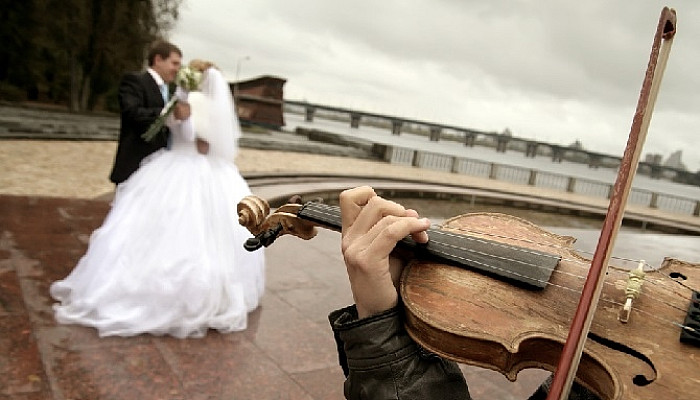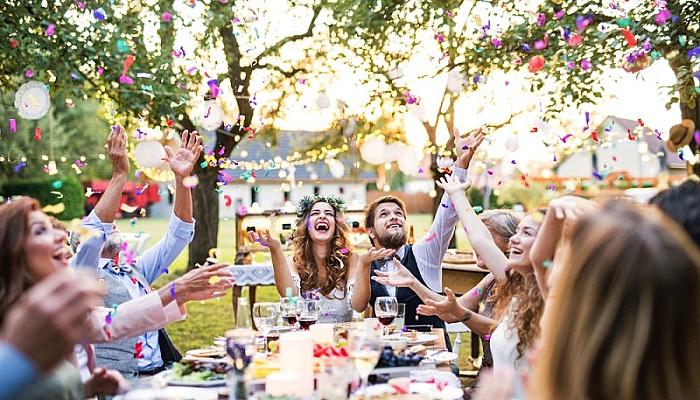Wedding Music

Wedding Music Defined
Wedding music applies to vocal and/or instrumental music performed at wedding rehearsals, rehearsal dinners, wedding ceremonies, and receptions (post-wedding party). In cultures of the Western Hemisphere, it initially provides background ambience for the audience as it assembles for the wedding. It then is used to announce and accompany a specific order of events, starting with the ritual seating of mothers and grandmothers by the ushers, followed by the entrance of the groomsmen and clergy, then the bridesmaids and lastly the bride herself. All these events are accompanied by their own individual pieces, selected beforehand in conjunction with the musician(s) hired to perform. In lieu of live players, recorded music can be substituted to fulfill these functions.
Wedding Music Traditions Around the World
Music of Modern Western Weddings
A contemporary American wedding ceremony, most often held in a church, typically begins with 20-30 minutes of prelude music. This generally includes reflective pieces such as Bach’s ” Jesu, Joy of Man’s Desiring “. Use of string quartets and harps have in modern times increased in popularity, sometimes replacing the customary organ. After the prelude, there is generally special music for the seating of the mothers and grandmothers. A popular selection in the United States is the Canon_in_D by Johann Pachelbel. Then the bridal party (bridesmaids) proceeds down the aisle, followed by the bride — often escorted by her father. They arrive at the church altar where the groom, groomsmen and minister are assembled. This bridal march is accompanied by a processional tune. For over 100 years the most popular processional has been Wagner’s Bridal Chorus from Lohengrin (1850), often called “Here Comes The Bride.” This has been historically played by an organist. Since the televised wedding of Lady Diana to Prince Charles, there has been an upsurge in popularity of Jeremiah Clarke’s “Trumpet Voluntary,” aka The Prince of Denmark’s Marche, formerly attributed to Clarke’s teacher, Henry Purcell.
During the service there may be a few hymns, especially in liturgical settings. Optional solos and a short piece for the lighting of the Unity Candle may also occur. At the end of the service, the bride and groom march down the aisle to a lively recessional tune, the most popular tune being Mendelssohn’s Wedding March from A Midsummer Night’s Dream (1826). Another popular choice is Widor’s Toccata from Symphony No. 5 (1880). The ceremony concludes with an instrumental postlude as the guests depart.
After a photography session, a catered meal and dance ensue, known as a reception. Some receptions offer couple dancing with a live band, but the more common trend in the United States and Western Europe is to hire a DJ to play popular recorded songs, often chosen by the couple.
Classical Music with Wedding Connections
Mozart’s “The Marriage of Figaro” and Mendelssohn’s “Midsummer Night’s Dream” contain wedding marches. Bach wrote a “Wedding Cantata” (1723) and Smetana wrote an opera called “The Bartered Bride”. Goldmark wrote a “Rustic Wedding Symphony”. Tippett wrote “The Midsummer Marriage” (1955). Stravinsky wrote “Les Noces”. Edmund Spencer ’s poem “Epithalamion” of 1595 is an ode to marriage. It has been set to music by Roberto Gerhard.
Jewish Weddings
At Jewish weddings, the entrance of the bride is accompanied by a tune called baruch haba. After the ceremony there is a traditional dance called the hora. This is a circle dance, with the men circling the groom and the women circling the bride.
Scottish Weddings
At traditional Scottish weddings there is often a dance, after the ceremony, called a ceilidh. This ceilidh involves traditional scottish music and has dances such as a “Strip the Willow,” “Dashing White Sergeant” and “The Gay Gordons” Mairi’s Wedding (aka Marie’s Wedding , the Lewis Bridal Song , or Mairi Bhan ) is popular in weddings with a Scottish theme. It was written by Johnny Bannerman using a traditional Scots tune in 1934 and translated from Gaelic into English a year later. It has since been recorded by Kenneth McKellar, The Clancy Brothers, The Chieftains with Van Morrison , The King’s Singers and others, with The Rankin Family taking it to number one in Canada.
Australian Civil Wedding
The majority of weddings in Australia are a civil ceremony performed by an Authorized Civil Celebrant. Municipal parks are popular followed by the reception venue itself, which may have its own garden or an attached secular wedding chapel. The choice of music reflects the comparatively informal and relaxed style of this unique form of wedding.
The choice of music reflects the couple’s musical tastes and ranges from classical to pop. It is sometimes played by hired professionals or friends who are trained musicians but is mostly supplied on CD-ROM and played by the celebrant on his or her portable public address system.
Light music, middle-of-the-road or classical, is played while the guests are gathering but this changes to a piece chosen by the bride for her entrance. The Canon in D by Johann Pachelbel is the most popular piece. The Bridal Chorus and Wedding March are regarded as musical cliches and rarely heard.
Quieter pieces are played while the marriage certificates are signed in the presence of the guests. After signing the official Certificate of Marriage is presented to the couple. The guests then stand while the bridal party exits, either down the aisle or nearby in the park. During this a bright, loud, cheerful piece is played to set a triumphant note at the end of the ceremony.
The Hawaiian Wedding Song
Coco Palms Resort was a luxury in Hawaii. It opened in 1953 and became the focus of the last 20 minutes of Elvis Presley’s film ” Blue Hawaii” (1961). The climax was a wedding with Elvis singing “The Hawaiian Wedding Song”. This had originally been written in Hawaiian by Charles E King in 1926. It had been given English lyrics by Hoffman and Mannin. Elvis’s version is a dual-language version of both songs. He sang it to his bride at his own wedding. As a direct result of the film, about 500 Americans per year were married at the Coco Palms Resort, and most of them used the famous song as part of the ceremony. Even after the hotel closed in 1992 the song is still a popular choice, especially for Presley fans.
Egyptian Weddings
In Egypt there is a specific rhythm called the zaffa. Traditionally a belly dancer will lead the bride to the Wedding Hall, accompanied by musicians playing the elzaff , on drums and trumpets, sometimes the flaming torches. This is of unknown antiquity, and may even be pre-Islamic.
Come Write Me Down
The traditional English “Wedding Song” is also known as “Come Write Me Down” or “The Second Answer is Better”. It dates from before 1820. A young man woos a woman, who replies saying her freedom is more important than marriage. Just as he turns to leave, she changes her mind and accepts his advances.



